Action Potential
What do the concentration and electrical gradients together explain?
They explain the movement of ions during an action potential.
What happens when positive charges reach the initial segment?
They push potassium ions, triggering movement and depolarization.
1/76
There's no tags or description
Looks like no tags are added yet.
Name | Mastery | Learn | Test | Matching | Spaced |
|---|
No study sessions yet.
77 Terms
What do the concentration and electrical gradients together explain?
They explain the movement of ions during an action potential.
What happens when positive charges reach the initial segment?
They push potassium ions, triggering movement and depolarization.
What does potassium movement down the axon lead to?
Depolarization of the next axon segment, continuing the action potential.
What is the resting membrane potential of a neuron?
Around -70 millivolts.
What is hyperpolarization?
When the internal potential becomes more negative.
What is depolarization?
When the internal potential becomes less negative.
What pushes ions from the soma into the axon hillock?
Postsynaptic potentials.
What effect do inhibitory postsynaptic potentials (IPSPs) have?
They hyperpolarize the initial segment, blocking action potentials.
What effect do excitatory postsynaptic potentials (EPSPs) have?
They cause depolarization and may lead to action potentials.
What is the period of latent addition?
A passive influence where charges build up in the initial segment before threshold is reached.
What determines if the threshold is reached?
It is a matter of probability based on charge accumulation.
Where does the period of latent addition occur?
In the axon hillock and initial segment.
What is a key property of the action potential?
It is all-or-none once started.
Why doesn’t the period of latent addition happen during an action potential?
The action potential is too fast for such gradual influences to occur.
Describe the axon membrane.
Bi-lipid layer, semi-permeable, selective.
What structures are embedded in the axon membrane?
Ion channels (proteins) and the sodium-potassium pump.
What is the function of the sodium-potassium pump?
Pushes sodium out and brings potassium in, maintaining water balance.
What are the two main types of ion channels?
Sodium and potassium channels.
What is the typical resting state charge inside the axon?
Between -30 to -90 millivolts
Where is sodium primarily located?
Outside the axon.
Where are chloride and potassium ions primarily found?
Inside the axon.
Why does potassium remain inside the axon despite gradient pressures?
Because the negative charge from anions attracts and holds it in.
What are the two types of potassium channels?
Passive and active.
What does a passive potassium channel do?
Allows potassium to move freely based on electrical gradient.
What is the typical resting membrane potential of a neuron?
Around -70 millivolts, though it varies from axon to axon.
What is the peak of an action potential?
+40 millivolts.
What happens during an inhibitory postsynaptic potential (IPSP)?
Negatively charged ions (anions) are forced into the initial segment, lowering the internal potential.
What effect does hyperpolarization have on the neuron?
It reduces the likelihood of an action potential being generated.
What causes hyperpolarization in the axon?
The influx of negatively charged ions due to an inhibitory postsynaptic potential.
Can the intensity of hyperpolarization vary?
Yes, it can be stronger or weaker depending on the strength of the IPSP.
Does the duration of hyperpolarization vary?
Yes, the number of milliseconds it lasts can vary.
What happens during an excitatory postsynaptic potential (EPSP)?
Positively charged ions are pushed into the axon hillock and initial segment, increasing the chance of an action potential.
What effect do excitatory postsynaptic potentials have on the axon initial segment?
They result in depolarization.
Can depolarizing forces vary in strength?
Yes, they may be small or large in magnitude.
What is meant by "threshold" in the context of action potential generation?
It's the 50% point where there’s an equal chance (50-50) of an action potential occurring.
Can a sub-threshold depolarization trigger an action potential?
Yes, but it’s not as likely.
What does it mean that postsynaptic potentials are additive?
Multiple hyperpolarizing or depolarizing inputs can combine to increase their effect on the cell's internal state.
What happens when multiple hyperpolarizing inputs arrive at the same time?
They make the internal state of the neuron more negative, decreasing the likelihood of an action potential.
What increases the likelihood of an action potential?
Influx of positively charged ions (cations) into the initial segment.
How much the likelihood increases depends on what factor?
The magnitude of the cation influx.
Do neurons only receive excitatory or inhibitory inputs at one time?
No, both excitatory and inhibitory synapses are influencing the neuron constantly.
Where is the period of latent addition observed?
Only in the initial segment of the axon during the beginning stages of action potential formation.
Will you see the period of latent addition once an action potential has fired?
No, it only occurs before the action potential is initiated.
What is the upward phase of the action potential called?
Depolarization.
Why is the term "depolarization" considered a misnomer?
Because it moves the membrane potential toward and past zero, not just away from it.
What is the Absolute Refractory Period?
The period when sodium channels are open in a patch of axon, and no new action potential can occur.
What triggers sodium channels to open?
A sufficient positive charge.
When do sodium channels close?
Around +40 millivolts, when the positive internal charge is high enough.
What happens after sodium channels close?
Potassium channels are active, and potassium efflux begins.
What is the Relative Refractory Period?
A period where potassium efflux occurs and a stronger-than-normal stimulus is needed to trigger another action potential.
Why is it called the "Relative" Refractory Period?
Because the ability to trigger another action potential depends on the strength of the incoming stimulus.
What is hyperpolarization?
When the internal state of the axon becomes more negative than the resting potential.
Why does hyperpolarization occur?
Due to lingering extracellular potassium before it diffuses away or re-enters the axon.
What initiates the depolarization of the next patch of axon?
Potassium ions pushed forward by sodium influx.
What role do sodium ions play in conduction?
They rush into the axon, causing a spike in membrane potential.
How many sodium and potassium ions move per action potential?
Few ions—around 7 sodium in, fewer potassium out and down the axon.
Where do ion channels operate in myelinated axons?
Only at the nodes of Ranvier
What is saltatory conduction?
Fast, jumping transmission of action potentials between nodes of Ranvier in myelinated axons.
What is non-saltatory conduction?
Slower, continuous conduction in unmyelinated axons
What does "orthodromic" mean?
Action potential travels from soma to bouton (correct direction).
What ensures orthodromic conduction?
Absolute refractory period (primarily) and relative refractory period (secondarily).
What is "antidromic" conduction?
When an action potential travels backward toward the cell body.
When might antidromic conduction occur?
When you hit your "funny bone" and pinch the ulnar nerve.
What sensory response results from antidromic conduction in the ulnar nerve?
Tingling and warmth spreading through the forearm
What are the four main properties of an action potential?
Threshold, All-or-Nothing, Self-Propagating, Nondecremental.
What is the "threshold" in action potentials?
A 50% probability point where an action potential may be triggered.
What is the sodium-potassium pump?
A protein that moves 3 sodium ions out and 2 potassium ions in.
What does the pump maintain?
Proper water balance in the neuron.
Why does sodium in your diet make you retain water?
Sodium is hydrophilic and attracts water.
What happens if cells retain too much water?
Cell bloating, damage, and possible death
Can action potentials still occur without sodium-potassium pumps?
Yes, neurons can generate thousands of action potentials even without the pump.
What is the primary role of the sodium-potassium pump?
Maintaining water balance inside neurons—not restoring ionic balance after each action potential.
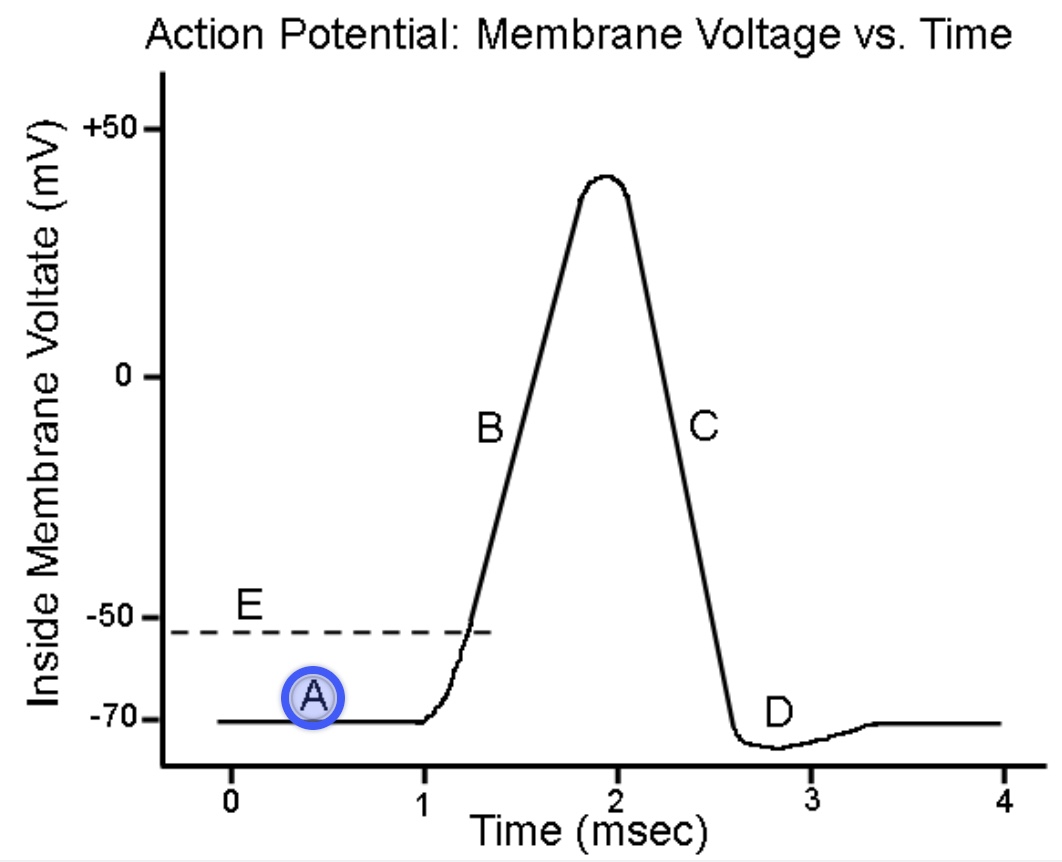
Resting state
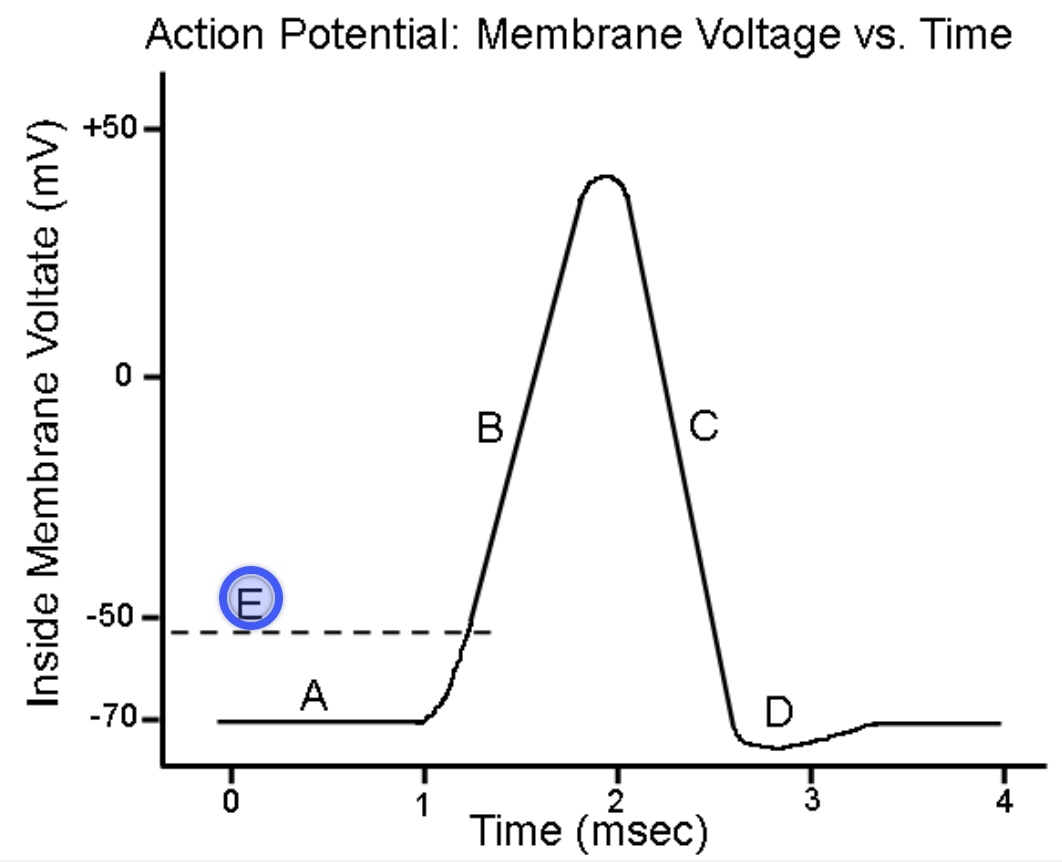
Threshold - Stimulus depolarizes the membrane to the minimum threshold of excitation
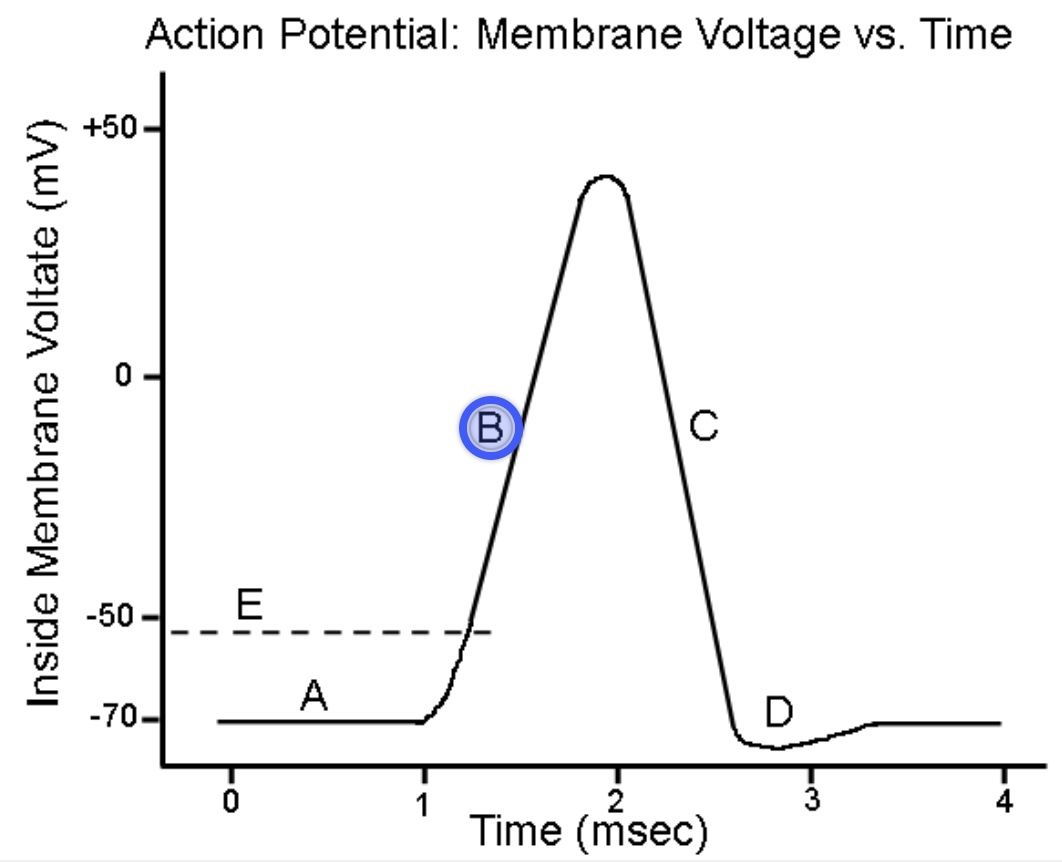
Depolarization - Na+ channels are the FIRST to open and Na+ enters the cell. It causes the inside of the cell to depolarize, or become more positive
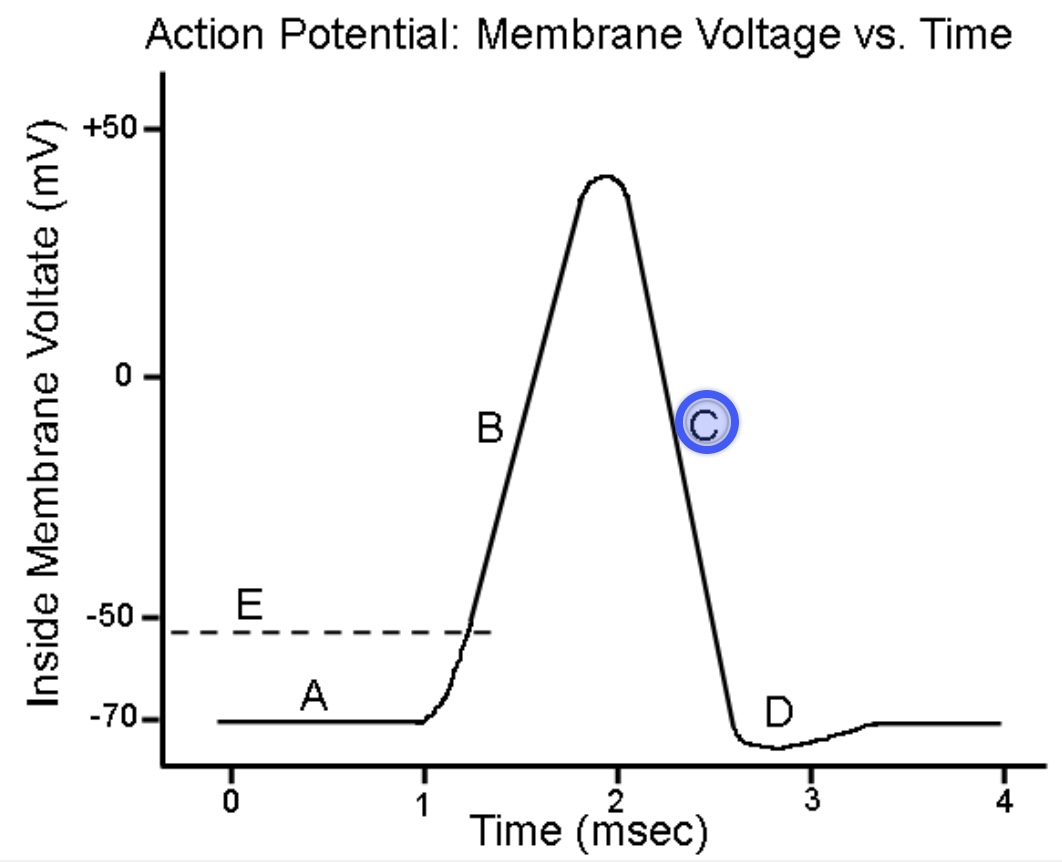
Repolarization - K+ entering the cell, thus the inside of the cell becomes more negative.
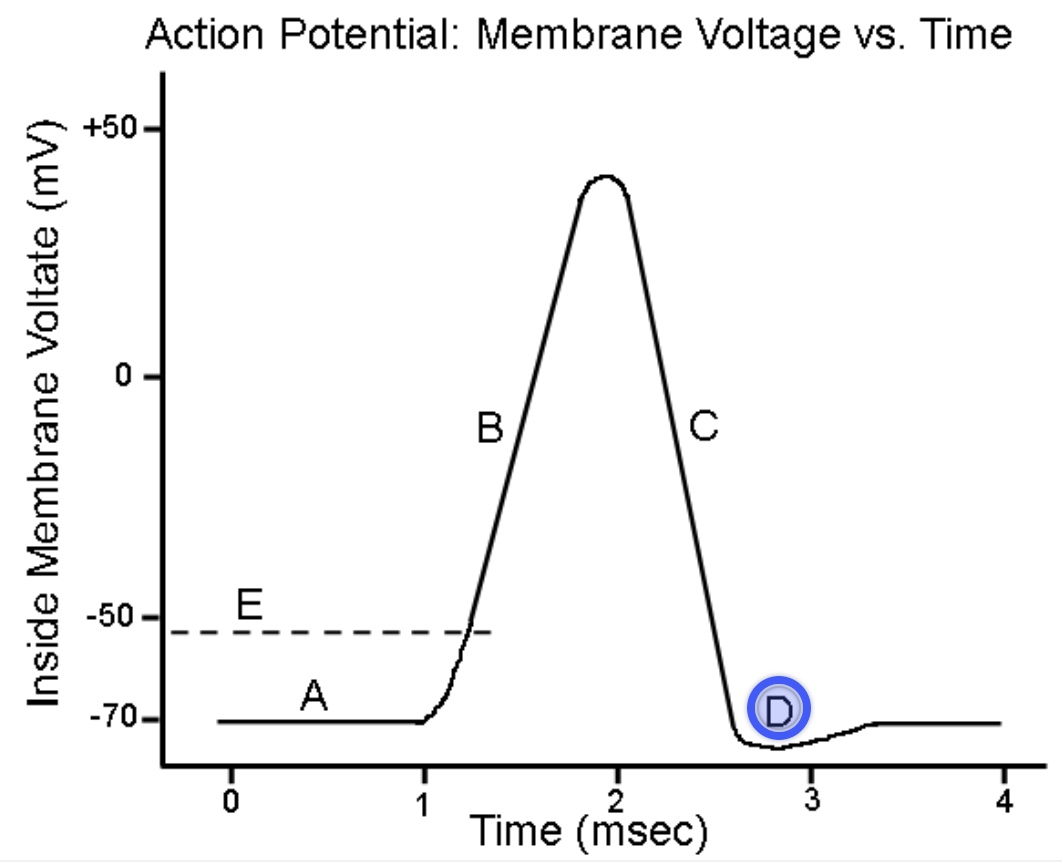
Hyperpolarization - The inside will become too negative, but it will go back to resting state because K+ ions diffuse away.